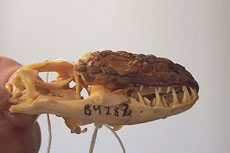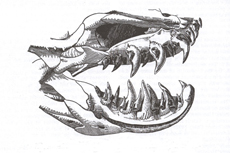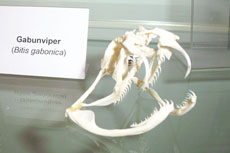
Venom of Heloderma
Gila Monsters deliver their venom by a firm bite and chewing movements with their jaws into the wound. The third to the sixth pair of dentaries (counted from the back) of the lower jaw are equipped with deep grooves and specially shaped teeth to assist in the best penetration and delivery of venom. Three to four pairs of venom glands in a series are placed on each side of the lower jaw. This supplies the grooves with venom through small drain ducts, which exit next to the grooved teeth. The venom produces considerable pain and metabolic disorders. (Ref. 82)
Venom teeth of the GILA MONSTER (Ref. 3) and venomous snakes: |
 |
 |
| Venom teeth of Heloderma suspectum | Position of replacement teeth of Heloderma suspectum |
Venom fangs of Vipers |
The potency of the Heloderma venom is believed to be similar to the venom of the Western Diamond Rattlesnake (Crotalus atrox) (Ref. 4).
Contents of Venom
- Enzymes
Contents: Physiological effects: Hyaluronidase "Spreading factor" facilitating the spread of venom into the surrounding tissue of the bite. Responsible for edema development Phospholipase A2 Hydrolase, catalysis hydrolysis of phospholipids - Hormones and Peptides with Bioactivity
Contents: Physiological effects: Serotonin Neurotransmitter mediates inflammation and vasodilation, effects on smooth muscle activity. Helothermine Glycoprotein causes lethargy, relaxation of muscles and hypothermia Gilatoxin Glycoprotein, a Kallikrein-like lethal toxin, lowers blood pressure and has influence on muscle tone. Helodermatine Glycoprotein, enzyme, reduces dose dependent arterial blood pressure. Helospectin
Exendin-1Stimulates amylase release of the pancreas, VIP-similar effects Helodermin
Exendin-2Peptide, stable secondary structure, causes hypotension, VIP- similar effects Exendin-4
EXENATIDEPeptide, activates insulin release though activation of the GLP-1-receptor in humans Gilatide Reacts on GLP-1-receptor, has improved memory in rodents EXENATIDE Is manufactured now synthetically in large quantities. It serves the treatment of diabetes-type-II (adult-onset diabetes). Type-II-patients have difficulty to adjust to physiological glucose levels. EXENATIDE acts with a different mechanism on the insulin output of the pancreas. This makes type-II-patients accessible to therapy. (Ref. 83, 84)
For extensive information about Heloderma venom read Dr. D. D. Beck (Ref. 1).
For more Information about the Biochemistry of Helodermatid Venom.
Charles Eugene Lidikay and Koni Stone (1997) (Ref.37), D.Mebs (Ref.38)
